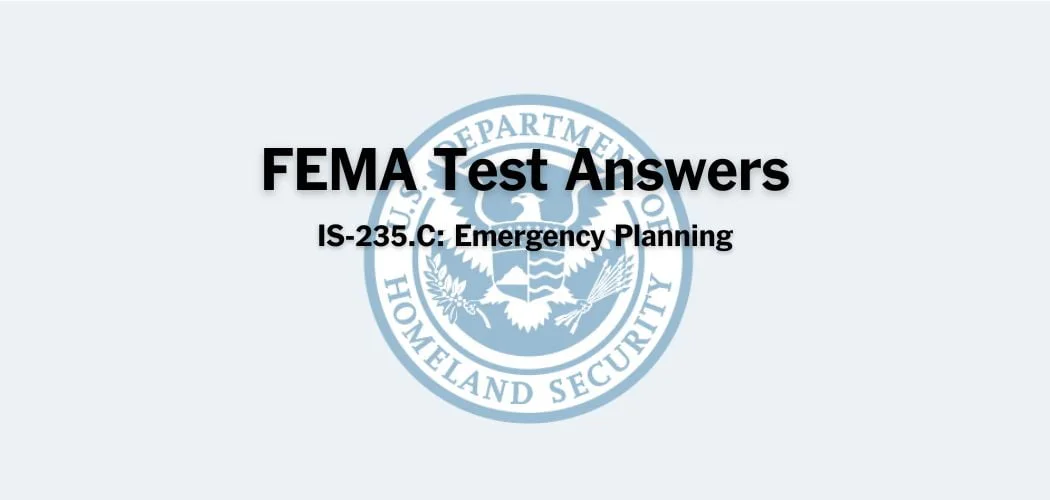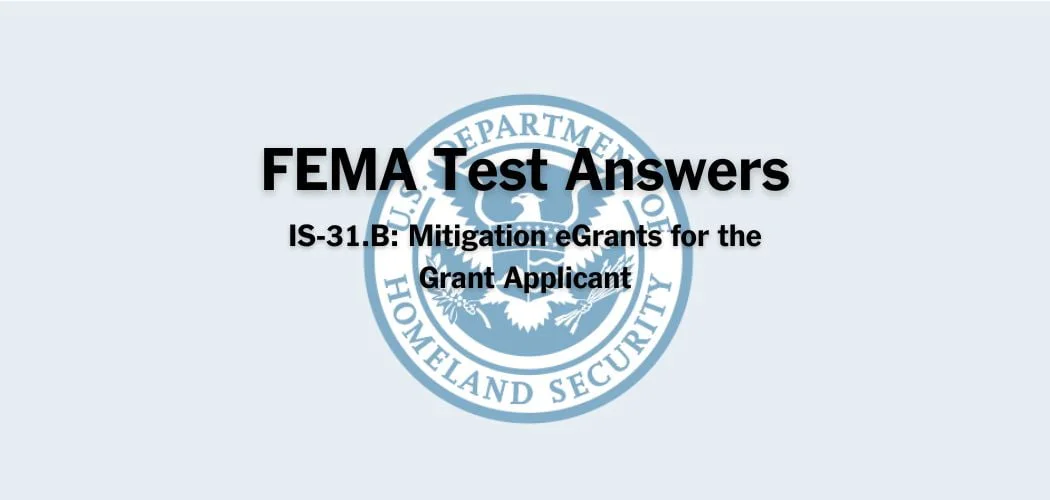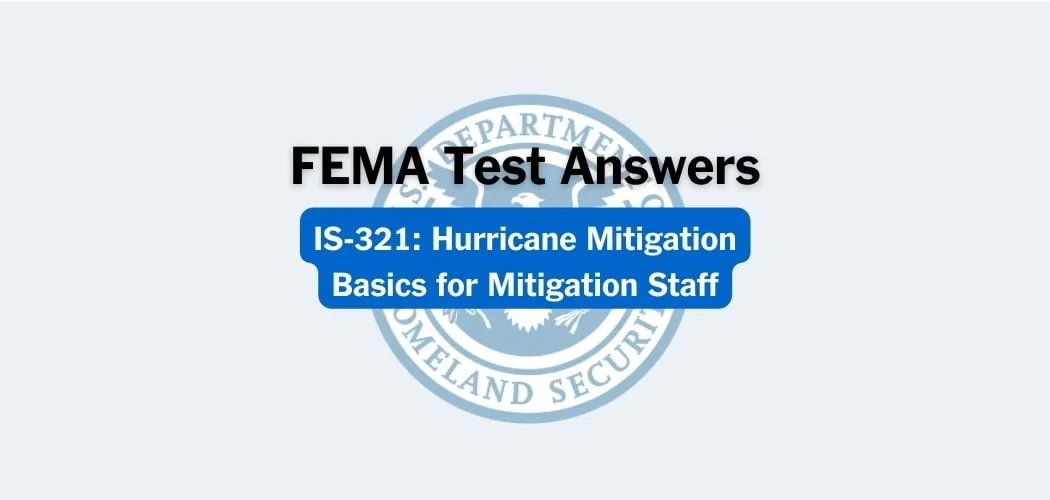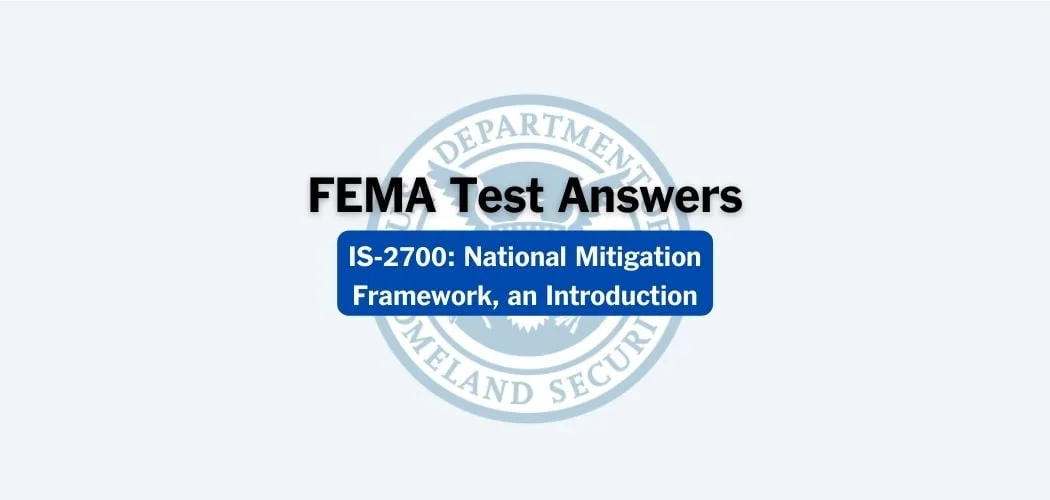Overview: FEMA IS-1172 was published on 8/21/2017 as the third course in the Interagency Security Committee (ISC) web-based training series. The purpose of this course is to provide Federal personnel with responsibilities for security-related policies, programs, projects, and/or operations for their department or agency an overview of the process to determine the Facility Security Level (FSL) for a Federal facility.
Primary audience: FEMA IS-1171 is for federal personnel with responsibilities for security-related policies, programs, projects, and/or operations for their department or agency
FEMA IS-1172 test answers
Each time this test is loaded, you will receive a unique set of questions and answers. The test questions are scrambled to protect the integrity of the exam.
Question 1. The FSL determination process permits adjustments to be made for intangible factors. Which of the following instances does the RMP define as intangible factors?
A. A short duration of occupancy
B. One-time, short-term events, such as a meeting or conference
C. Recurring short-term events
D. The potential for cascading effects due to proximity to other facilities
E. All of the above except B✅
Question 2. The facility security level determination permits adjustments to be made for:
A. Threat to tenant agencies
B. Replacement value
C. Intangible factors✅
D. Continuity of government functions
Question 3. The facility security level that requires the highest level of protection is:
A. Level III
B. Level I
C. Level A
D. Level V✅
Question 4. A facility with a child-care center will automatically:
A. Receive a facility population score of ‘very high’ and a point value of 4
B. Receive an additional point to the facility population score, not to exceed 4 points✅
C. Receive 2 additional points to the facility population score, not to exceed 4 points
D. Receive a facility population score of ‘high’ and a point value of 3
Question 5. Federal facilities are categorized into how many security levels?
A. Five✅
B. Two
C. Three
D. Four
Question 6. How many factors are used to determine an FSL?
A. Five
B. Two
C. Three
D. Four✅
Question 7. The facility population factor is based on:
A. The peak number of personnel and visitors in Government leased/owned spaces on a daily basis, not including fluxes for occasional events✅
B. The average daily population of Federal employees and visitors, not including influxes for occasional events
C. The average daily Federal and visitor population in the past year, including onsite contract employees and conference center attendees
D. The peak number of employees and visitors to the entire facility on a daily basis
Question 8. The responsibility for making the final facility security level determination rests with:
A. The Interagency Security Committee
B. The facility tenant(s) or designated representatives
C. The owner of the facility
D. Designated security officers of the Department of Homeland Security
E. Both A and B
F. Both C and D✅
Question 9. True or False. The preliminary FSL can be adjusted up or down two levels based on intangible factors?
A. TRUE
B. FALSE✅
Question 10. True or False. In a multi-tenant facility, the Security Organization makes the final FSL determination.
A. TRUE
B. FALSE✅
Question 11. Which of the following conditions might warrant an adjustment to a facility’s security level?
A. A specific threat act.
B. Designation of the facility as the location for an upcoming conference of world financial leaders.✅
C. Change in tenant agency leadership.
D. Change in tenant mission.
Question 12. The security evaluation factors used to determine the facility security level without intangible adjustments are:
A. Mission criticality, symbolism, facility population, facility size, and replacement value.
B. Mission criticality, symbolism, facility population, facility size, and threat to tenant agencies.
C. Mission criticality, facility population, facility size, replacement value, and threat to tenant agencies.✅
D. Mission criticality, facility population, visitor population, facility size, and replacement value.
Question 13. Guidance on how to perform an FSL determination can be found in:
A. The Risk Management Process for Federal Facilities: An ISC Standard✅
B. Facility Security Plan: An ISC Guide
C. Appendix F: Forms and Templates
D. Appendix A: (FOUO) Design-Basis Threat Report
Question 14. True or False. The preliminary facility security level for a facility is determined using the average of factor scores from the Facility Security Screening tables.
A. TRUE
B. FALSE✅
Question 15. True or False. The facility security level is the initial estimation of the risk to a Federal facility based on specific security evaluation factors.
A. TRUE
B. FALSE✅
Question 16. How often is the FSL required to be re-evaluated in level I & II facilities?
A. Every 2 years
B. Annually
C. Every 3 years✅
D. Every 5 years
Question 17. Which document contains details on determining the Facility Security Level?
A. Appendix B – Countermeasures
B. Executive Order 12977: Interagency Security Committee
C. Risk Management Process for Federal Facilities✅
D. The Facility Security Level Handbook
Question 18. The facility size factor is based on:
A. The square footage of all occupied space in the facility✅
B. The square footage of all Federally-occupied space in the facility
C. The square footage of all space in the facility and associated parking garages
D. The square footage of the space occupied by the tenant with the highest mission criticality score
Question 19. How often is the FSL required to be re-evaluated in Level III, IV & V facilities?
A. Every 2 years
B. Every 3 years✅
C. Annually
D. Every 5 years
Question 20. True or False. The FSL determination is the 2nd step in the Risk Management Process.
A. TRUE
B. FALSE✅
Question 21. The Risk Management Process for Federal Facilities defines a “facility” as a space built or established to serve a particular purpose. In accordance with this definition, which of the following examples is considered a “facility”?
A. A single building
B. Several buildings
C. Land
D. Office suite
E. All of the above✅
Question 22. Which security evaluation factor is based largely on the mission of the facility, particularly as it may relate to National Essential Functions (NEF) and other important business of the Government.
A. Threat to Tenant Agencies
B. Symbolism
C. Mission Criticality✅
D. Facility Population
Critical Infrastructure Security and Resilience Curriculum
Sector-specific courses
- IS-870: Dam Sector: Crisis Management
- IS-871: Dam Sector: Security Awareness
- IS-872: Dam Sector: Protective Measures
- IS-1170: Introduction to the Interagency Security Committee (ISC)
- IS-1171: Overview of Interagency Security Committee (ISC) Publications
- IS-1172: The Risk Management Process for Federal Facilities: Facility Security Level (FSL) Determination
- IS-1173: Levels of Protection (LOP) and Application of the Design-Basis Threat (DBT) Report
- IS-1174: Facility Security Committees
Foundational courses
- IS-860: The National Infrastructure Protection Plan
- IS-913: Critical Infrastructure Security and Resilience: Achieving Results through Partnership and Collaboration
Security awareness courses
- IS-906: Workplace Security Awareness
- IS-907: Active Shooter: What You Can Do
- IS-912: Retail Security Awareness: Understanding the Hidden Hazards
- IS-914: Surveillance Awareness: What You Can Do
- IS-915: Protecting Critical Infrastructure Against Insider Threats
- IS-916: Critical Infrastructure Security: Theft and Diversion – What You Can do



